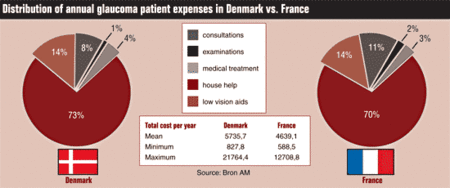Study finds higher than expected medical glaucoma treatment rate in France
Compliance and quality of life decrease with the number of daily doses of glaucoma medications.
Click Here to Manage Email Alerts
PARIS – A study demonstrated that 4.1%, or 1.2 million people, of the French population are medically treated for glaucoma or ocular hypertension.
![Alain M. Bron, MD [photo]](/~/media/images/news/print/ocular-surgery-news-europe-asia-edition/2006/09_september/bron_70_90_18122.jpg) Alain M. Bron |
“These numbers are higher than we expected and are, however, an underestimation of the actual number of glaucoma cases in France. In this study we did not include patients who had surgery and take no drugs, and patients with ocular hypertension who are only kept under medical surveillance. In addition, many glaucoma cases still go undetected,” said Alain M. Bron, MD, at the annual meeting of the French Society of Ophthalmology (SFO).
Up to now, the prevalence of glaucoma and ocular hypertension in France had been estimated at around 600,000 to 800,000, ie 2% of the population over 40 years of age. According to the Comité de Lutte Contre le Glaucome (committee to fight glaucoma), an additional 500,000 to 700,000 people in France are affected by the disease but are not aware of it or neglect treating it. Because no proper population study had been previously carried out, these numbers were essentially based on the data of other countries in and outside Europe.
“The aim of our study was to try and evaluate the actual prevalence of patients treated with IOP-lowering drugs, to assess the compliance of these patients and to evaluate the impact of the disease on the quality of life,” Prof. Bron said.
A population sample of 10,051 individuals were contacted by telephone between September and November 2004, and the 5,726 that were 40 years or older were interviewed.
Among those, 804 said they use glaucoma eye drops on a regular basis, and 621 said they had been using them for at least 1 month.
“We included in the study the 237 patients who could mention at least one of the 52 medications available on the market in France and/or were aware that they were taking these drugs to treat glaucoma or ocular hypertension. Proportionally, this number represents 4.1% of the French population,” Prof. Bron said.
The prevalence increased regularly with age. No significant difference was found between men and women.
Prevalence was higher in areas with a higher population density, in larger towns, and lower in areas with fewer medical services, where there is probably a higher number of undetected cases, Prof. Bron noted.

Compliance a concern
The study showed that about one-third of the patients are treated with one drop a day, one third take two drops and one third take three or more drops. The most commonly used types of drugs were beta-blockers (59.6%), followed by prostaglandins (45.1%).
“Data were collected 2 years ago, when beta-blockers were still the most commonly used treatment. An update of the study would probably show the more recent shift toward prostaglandins,” Prof. Bron said.
As far as compliance was concerned, 39% of the patients admitted they are not always regular in taking their medications. Most of them (69%) were between the ages of 40 and 49 years.
“Younger patients tend to underestimate the importance of regular treatment, and in some cases deny the severity of their disease,” Prof. Bron said.
As demonstrated by several other studies, poor compliance was also closely related with the number of daily instillations.
While the patients taking their medications regularly were 78% with one drop, the rate decreased to 54% with two drops and to 43% with three or more drops.
“Poor compliance is a huge concern when we treat our patients,” Prof. Bron admitted. “In this study we also found that it usually correlates with the lower scores given to various items concerning quality of life. In quite a number of patients the constant need for repeated doses of daily medications seems to affect self image, cause psychosocial problems and generate a feeling of constraint in everyday life.”
Though approximate, he concluded, these data can be useful for all the professionals involved in the medical, economic and social management of ocular diseases.
They also confirm that more has to be done for the detection of glaucoma, particularly in areas with lower population density and fewer medical services.
“In the future, we should also be able to provide a closer monitoring of the regularity of the treatment and new treatment strategies with a less traumatic impact on the patient’s quality of life.
For more information:
- Alain M. Bron, MD, is Professor of Ophthalmology at the University of Dijon. He can be reached at Hopital Général, 3 Rue de Faubourg Raines, BP 519 21033 Dijon, France; +33-3-80293756/80293277; fax: +33-3-80293589; e-mail: bronalain@wanadoo.fr/Alain.Bron@CHU-Dijon.fr.
- Michela Cimberle is an OSN Correspondent based in Treviso, Italy, who covers all aspects of ophthalmology. She focuses geographically on Europe.
